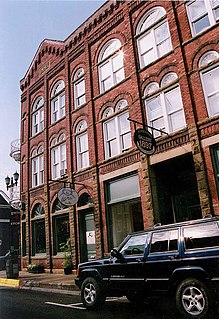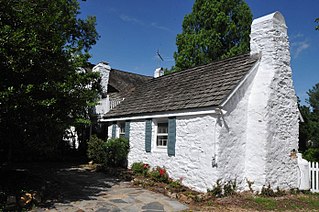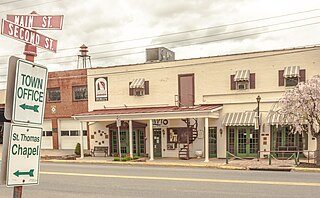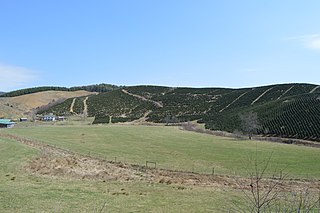
The Clarksville Historic District is a national historic district located at Clarksville, Mecklenburg County, Virginia. It encompasses 171 contributing buildings, 2 contributing sites, and 1 contributing structure in the central business district and surrounding residential areas of the town of Clarksille. Notable buildings include the Planters Bank (1909), Planters Brick Tobacco Sales Warehouse, Gilliland Hotel, the Russell's Furniture, former Clarksville High School (1934), Clarksville Presbyterian Church, Mount Zion Baptist Church, Jamieson Memorial Methodist Episcopal Church (1901), St. Timothy's Episcopal Church (1917), and St. Catherine of Siena Roman Catholic Church (1947). Located in the district are the separately listed Clark Royster House and the Judge Henry Wood Jr. House.

The Batesville Historic District is a national historic district located at Batesville, Albemarle County, Virginia. In 1999, when it was listed on the National Register of Historic Places, it included 33 buildings deemed to contribute to the historic character of the area. They include representative examples of the early-19th century Federal Style, the mid-19th century Greek Revival Style, simple late-Victorian styles from the late-19th century- and early-20th century, Classical Revival and Colonial Revival styles. Notable buildings include the Batesville Elementary School (1922), Batesville Public School, Mount Ed Baptist Church, Batesville Methodist Church (1861), Dr. Smith House, the Barskdale House, Hill House, and Page's Store.

West Point Historic District is a national historic district located at West Point, King William County, Virginia. The district encompasses 75 contributing buildings and 1 contributing object in the town of West Point. The district includes residential, commercial, and institutional buildings and is notable for its variety of late-19th- and early-20th-century styles and building types. Notable buildings include the William Mitchell House, Anderson-Mayo House, Ware House, St. John's Episcopal Church (1882), Mt. Nebo Baptist Church (1887), West Point United Methodist Church (1889), O'Connor Hotel and annex, Treat-Medlin House (1898), Gouldman House (1923), First Baptist Church (1926), U.S. Post Office (1931), West Point Town Office Building, Citizens and Exchange Bank (1923), and Beverly Allen School (1930s).

Lewisburg Historic District is a national historic district located at Lewisburg, Greenbrier County, West Virginia. The district encompasses 112 contributing buildings and are representative of the development and evolution of Lewisburg, over a period of more than two centuries (1763-1977). Notable buildings include log cabins dating to the period 1755–1769, "The Barracks," Mount Esperance (1814), Williams-Henning Store/house (1814-1820), Welch-Bell House (1824), John W. Dunn House, John Withrow's Store/ House (1836), Greenbrier Valley Bank Building (1897), and Carnegie Hall (1902). Located in the district and separately listed are the Old Stone Church, Greenbrier County Courthouse and Lewis Spring, John Wesley Methodist Church, Gov. Samuel Price House, Mt. Tabor Baptist Church, Supreme Court Library Building, James Withrow House, and John A. North House.

Mt. Sidney School is a historic public school building located at Mount Sidney, Augusta County, Virginia. the original portion was built in 1912, and is the front gable-roofed, two-story block with an I-house plan consisting of two rooms and a central hallway on each floor. It features a central cross gable, one-story, three-bay porch. A four-room brick addition was built in 1921 and a gymnasium added in 1935. The school closed in 1967, and was subsequently remodeled into apartments.

Buchanan Historic District is a national historic district located at Buchanan, Botetourt County, Virginia. It encompasses 277 contributing buildings, 5 contributing sites, and 4 contributing structures in Buchanan and Pattonsburg on both sides of the James River. They include commercial, transportation-related, domestic, religious, and industrial resources associated with the community's development from the late-18th century through the late-20th century. Notable buildings include the Pattonsburg Mill (1838), Buchanan Presbyterian Church (1845), Trinity Episcopal Church (1842), Hotel Botetourt (1851), Sorrell House (1850), James Evans Mason Lodge (1884), Virginia Can Company complex (1903), "Oak Hill" (1840), Town Hall Municipal Building, Bank of Buchanan, Ransone's Drugstore, Buchanan Theatre (1919), and Buchanan High School (1928). The contributing sites include the James River & Kanawha Canal project site, Johnston-Boyd Cemetery (1835–1906), and Mountain View Cemetery (1854). The contributing structures include the Stone Arch Tunnel (1870s). Also located in the district is the separately listed Wilson Warehouse.

The Charlotte Court House Historic District is a national historic district located at Charlotte Court House, Charlotte County, Virginia. The district includes 46 contributing buildings, 2 contributing sites, 3 contributing structures, and 2 contributing objects in Charlotte Court House. The district is centered on the separately listed Charlotte County Courthouse. Other notable buildings include the former county jail (1936), Brick Tavern (1820), Charlotte County Farm Bureau building, St. John's Masonic Lodge (1852), Charlotte County Public Library, Village Presbyterian Church and cemetery (1835), Charlotte Court House United Methodist Church (1841), Diamond Hill, Villeview, W. B. Ramsey House, Charlotte County Elementary School (1908), and Randolph-Henry High School (1939–1940).

Orlean Historic District is a national historic district located at Orlean, Fauquier County, Virginia. It encompasses 51 contributing buildings and 2 contributing sites in the rural village of Orlean. The district includes commercial buildings, churches, a post office, a former school, and multiple residences and their ancillary outbuildings that date from the late 18th century to the mid-20th century. Notable buildings include the Orlean Farm House, Smith-Hinkley House, the Anderson-Rector House and Store, the Greek Revival style Thorpe-Cornwell House, Jeffries Store (1885), Orlean Methodist Church (1881-1883), Providence Baptist Church (1883), and Orlean post office building (1956).

Paris Historic District is a national historic district located at Paris, Fauquier County, Virginia. It encompasses 53 contributing resources in the rural village of Paris. The district includes primarily residences, although the district also includes some commercial buildings, churches, a former school, and a cemetery. Fifty-two of the 53 contributing resources are already listed as part of the Crooked Run Valley Rural Historic District. Notable buildings include "Wagoner's Stand", the Josiah Murray House, the William Peck House, Old Paris Meeting House, the Willis-Carr House, the former Rogers Store, and Trinity United Methodist Church (1892).

Rectortown Historic District is a national historic district located at Rectortown, Fauquier County, Virginia. It encompasses 76 contributing buildings, 3 contributing sites, and 2 contributing structures in the rural village of Rectortown. The district includes dwellings dating back to the 18th century, churches, a school, an Odd Fellows hall, a post office, multiple commercial buildings, and several cemeteries that illustrate the town's growth and development. Notable buildings include the Maidstone Ordinary, the Rector-Slack Log House, the Ashby House, the Georg Mann House, The Brick Store House, Rector's Warehouse and Station, Denham, Maidstone, Rectortown United Methodist Church (1894), the Jackson-Grant House (1924), Slack's Store (1890), and the Mt. Olive Odd Fellows Lodge (1935).

Rocky Mount Historic District is a national historic district located at Rocky Mount, Franklin County, Virginia. It encompasses 211 contributing buildings, 2 contributing sites, 1 contributing site, and 2 contributing objects in the central business district and surround residential areas of Rocky Mount, county seat of Franklin County. It includes residential, commercial, institutional, and governmental buildings dated from the early- to mid-19th through early 20th centuries. Notable buildings include the Rakes Building (1929), N&W Freight Depot, Mount Pleasant (1828–1829), The Taliaffero Building (1827–1828), The Grove (1850), McCall House, Lodge Rooms (Colored), Trinity Episcopal Church, Rocky Mount Presbyterian Church, Baptist Church (Colored), N. Morris Department Store / Bryd Balm Company, Franklin County Courthouse (1909), Franklin County Jail (1938), Franklin County Library (1940), Rocky Mount Municipal Building (1929), and a Lustron house known as the Davis House (1949). Located in the district and separately listed are the Woods-Meade House and the Greer House.

Middletown Historic District is a national historic district located at Middletown, Frederick County, Virginia. It encompasses 234 contributing buildings in the town of Middletown. The majority of the buildings are residential and their associated outbuildings. The non-residential historic structures include four specialty shops, a theater, four churches, the Town Hall, two former schools, three warehouses and an inn. Notable buildings include Middletown Mission Church, Grace United Methodist Church (1897), Mt. Zion Church (1880), the former Middletown School (1909), the Town Hall (1880), The Wayside Inn, Larrick's Tavern, Wayside Theatre (1946), and Lafolette House. Located in the district and separately listed is the St. Thomas Chapel.

Spring Valley Rural Historic District is a national historic district located near Fries, Grayson County, Virginia. The district encompasses 184 contributing buildings, 3 contributing sites, and 1 contributing object in the wooded and agricultural northeastern corner of Grayson County. It includes mostly frame or log structures, with a few brick buildings, and several well-preserved examples of early-19th century log dwellings still in use. Notable buildings include the Knob Fork Primitive Baptist Church, William Bourne House "Walnut Hill", Austin King House, Tomlinson House, O'Donnell Place, Ephraim Boyer House, John Fielder Farmhouse, Ebenezer Methodist Church and Cemetery, Spring Valley Academy, Glenn Cornett House (1904), and Phipps Bourne Farmstead (1909). Located in the district is the separately listed Stephen G. Bourne House.

Round Hill Historic District is a national historic district located at Round Hill, Loudoun County, Virginia. It encompasses 204 contributing buildings, 1 contributing site, and 1 contributing structure in the town of Round Hill. It includes a variety of residential, commercial, and institutional buildings, with the majority built between 1880 and 1920. Notable buildings include the Gregg-Parks-Potts House, Guilford Gregg Store, Sagamore Hall, James Copeland House (1886), Hibbs House, African Methodist Church (1892), Mount Zion Baptist Church, Round Hill Baptist Church, Round Hill United Methodist Church, Castle Hall, Ford's Store, Round Hill Grocery, and the former Round Hill Railroad Depot (1902).

Heathsville Historic District is a national historic district located at Heathsville, Northumberland County, Virginia. The district includes 81 contributing buildings, 12 contributing sites, 4 contributing structures, and 4 contributing objects in the county seat of Northumberland County. It is an assemblage of residential, commercial, and government buildings dating from the 18th through 20th centuries in a variety of popular architectural styles. The linear district is centered on the courthouse square. Notable buildings include the Northumberland Court House, the old county jail (1844), the former Methodist Protestant Church, Harding House, Belleville, Heathsville Masonic Lodge No. 109 (1894), Bank of Northumberland (1924), and the Heathsville United Methodist Church (1894). Located in the district and separately listed are Rice's Hotel, Oakley, St. Stephen's Church, Sunnyside, and The Academy.

Mount Jackson Historic District is a national historic district located at Mount Jackson, Shenandoah County, Virginia.

Marion Historic District is a national historic district located at Marion, Smyth County, Virginia. The district includes 361 contributing buildings, 2 contributing sites, and 1 contributing object in the central business district and surrounding residential areas of Marion. It includes a variety of residential, commercial, institutional, industrial, and governmental buildings primarily dating from the mid-19th to mid-20th centuries. Notable buildings include the Sheffey Loom House, Odd Fellows Lodge, Look & Lincoln Wagon Factory warehouse, the Beaux-Arts style Marion County Courthouse (1905), Mt. Pleasant Methodist Church, Courtview Building (1890s), Marion High School (1907-1908), Marion Junior College (1912), the Overall Factory, Weiler Building, Bank of Marion (1922), Royal Oak Presbyterian Church (1923), Marion Municipal Building (1935), Marion Post Office (1936), and a Lustron house (1948). Also located in the district are the separately listed Hotel Lincoln, Lincoln Theatre, Marion Male Academy, and Norfolk & Western Railway Depot.

Stuart Addition Historic District is a national historic district located at Staunton, Virginia. The district encompasses 93 contributing buildings in a primarily residential section of Staunton. The district includes some early 19th-century structures, but most of the homes were built after 1870. The medium-density residential area includes notable examples of the Colonial Revival, Italianate, and Gothic Revival styles. Notable buildings include the Blakely or Templeton House, Steele House (1928), Kivlighan House (1910), Arlington Flats, D. Webster Davis School (1915), St. Francis of Assisi Catholic Church (1895), Augusta Street Methodist Church, Ebenezer Baptist Church (1910), and Mt. Zion Baptist Church (1904). Located in the district is the separately listed C. W. Miller House.

Suffolk Historic District is a national historic district located at Suffolk, Virginia. The district encompasses 514 contributing buildings, 3 contributing structures, and 3 contributing objects in Suffolk. The district includes a variety of residential, commercial, governmental, and institutional buildings. They are in a variety of vernacular and popular 19th and 20th century architectural styles including Greek Revival, Queen Anne, and Bungalow. Notable buildings include the Allmond Building (1914), Macedonia A.M.E. Church, National Bank of Suffolk (1914-1920), the Old Post Office, old Nansemond County Courthouse, John Granberry house, Richard Seth Eley House (1878), Jones Building, Suffolk Towers, Virginia Apartments (1918-1920), Causey-Kendrick house (1882), Masonic Hall (1911), Suffolk High School (1922), Jefferson High School (1911), old Methodist Church (1861), St. Paul's Episcopal Church (1895), Suffolk Christian Church (1893), and Congregation of Agudath Achin. Located in the district are the separately listed Phoenix Bank of Nansemond, Professional Building, and Riddick House.
Mount Olive Historic District is a national historic district located at Mount Olive, Wayne County, North Carolina. The district encompasses 465 contributing buildings, 2 contributing structures, and 1 contributing object in the central business district and surrounding residential sections of Mount Olive. It developed between about 1838 and 1949, and includes notable examples of Italianate and Queen Anne style architecture. Located in the district are the separately listed former United States Post Office, Mount Olive High School (Former), Southerland-Burnette House, and Perry-Cherry House. Other notable contributing buildings are the Elms, Mount Olive Presbyterian Church (1916), Carver High School (1941), Wooten & Brothers Building, DeBrutz English House, Center Theatre (1947), Mount Olive Manufacturing Company (1914), Farrior-Wooten House, Mount Olive First United Methodist Church (1911-1913), Mt. Olive Pickle Co. Office (1920), Mount Olive Passenger Depot, and Ebenezer Apostolic Holiness Church (1850).























